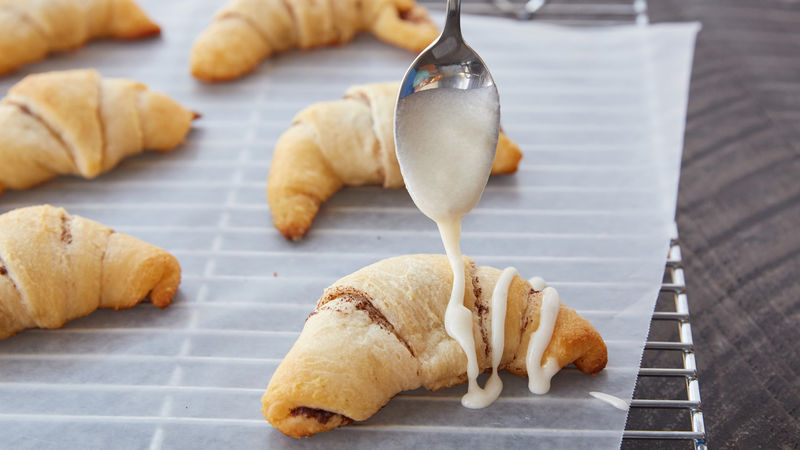Powdered sugar glaze—it sounds simple, right? But this deceptively easy confection can transform even the humblest baked good into a showstopper. From the delicate dusting on a delicate petit four to the thick, luscious coating on a cinnamon roll, a powdered sugar glaze’s versatility is only matched by its deliciousness. This guide dives deep into the art of the perfect powdered sugar glaze, covering everything from basic techniques to advanced flavor combinations and troubleshooting those pesky glaze mishaps.
We’ll explore the science behind different consistencies, the magic of flavor infusions, and the creative possibilities for design. Whether you’re a seasoned baker or just starting out, you’ll find tips and tricks to elevate your baking game with this incredibly adaptable topping.
Powdered Sugar Glaze: A Sweet and Simple Guide
Powdered sugar glaze is a versatile and easy-to-make topping that elevates countless baked goods. From delicate cookies to decadent cakes, its simple elegance adds a touch of sweetness and visual appeal. This guide will delve into the fundamentals of powdered sugar glaze, covering its composition, preparation methods, applications, troubleshooting, and advanced techniques.
Defining Powdered Sugar Glaze
A powdered sugar glaze is essentially a mixture of powdered sugar and a liquid, often enhanced with flavorings. The powdered sugar provides sweetness and structure, while the liquid acts as a binder, controlling the glaze’s consistency. Flavorings add depth and complexity to the final product.
Powdered sugar, the primary ingredient, contributes sweetness and a fine texture. The liquid, typically milk, water, or juice, is crucial for creating the desired consistency, ranging from a thin drizzle to a thick, creamy topping. Common flavorings include vanilla extract, lemon zest, almond extract, or spices like cinnamon. The ratio of liquid to powdered sugar directly impacts the glaze’s consistency: a higher liquid ratio results in a thinner glaze, while a lower ratio creates a thicker one.
For example, using more milk will result in a thinner, pourable glaze, while using less will produce a thicker glaze suitable for spreading.
Examples of flavor additions and their effects include vanilla extract (subtle sweetness and warmth), lemon zest (bright citrus notes and slight texture), and cinnamon (warm spice and subtle color). These additions not only enhance the taste but can also subtly affect the texture, adding a slight graininess (with zest) or creating a more opaque glaze (with spices).
Methods of Preparation
Creating a powdered sugar glaze is straightforward. The process involves gradually whisking the liquid into the powdered sugar until the desired consistency is reached. Adjusting the liquid amount allows for control over the thickness. Flavorings are incorporated at the end to prevent clumping.
- Sift powdered sugar into a bowl to remove any lumps.
- Gradually add your chosen liquid (milk, water, juice, etc.), whisking constantly to prevent clumping.
- Continue whisking until you achieve the desired consistency (thin, medium, or thick).
- Stir in your chosen flavorings (extracts, zest, spices).
Achieving different consistencies involves adjusting the liquid-to-powdered sugar ratio. A thin glaze requires more liquid, while a thick glaze needs less. Incorporating flavorings is best done after the base glaze is mixed to prevent clumping. Extracts are easily stirred in, while zest might require a bit more gentle mixing to avoid creating a lumpy texture. Spices should be added sparingly and mixed well to ensure even distribution.
| Glaze Type | Preparation Technique |
|---|---|
| Thin Drizzle | High liquid-to-powdered sugar ratio; whisk until smooth and pourable. |
| Medium Consistency | Balanced liquid-to-powdered sugar ratio; whisk until smooth and spreadable. |
| Thick Glaze | Low liquid-to-powdered sugar ratio; whisk until smooth and thick enough to hold its shape. |
Applications of Powdered Sugar Glaze
Source: bestdessertrecipes.com
Powdered sugar glaze is incredibly versatile. Its application depends on the desired look and the texture of the baked good. It can be drizzled, poured, or used as a dip.
- Cookies: A thin glaze creates a delicate sheen; a thicker glaze provides more coverage.
- Cakes: A medium consistency is ideal for a smooth, even coating.
- Donuts: A thick glaze offers a substantial coating.
- Bread: A light dusting or a thin glaze enhances the visual appeal.
The benefits include ease of application, visual appeal, and enhanced flavor. Drawbacks can include potential for uneven coating on uneven surfaces and the possibility of the glaze becoming too runny in warm conditions. Creative designs can be achieved through drizzling techniques (using a spoon or piping bag), dipping (fully submerging the baked good), or pouring (for a more rustic look).
The glaze’s visual appeal significantly enhances the baked good’s presentation, adding a touch of elegance and sophistication.
Troubleshooting Common Issues
Common problems during glaze preparation include clumping and inconsistent texture. These are usually easily resolved.
- Clumping: This is often caused by not sifting the powdered sugar. Sifting removes lumps and ensures a smooth glaze. Adding more liquid can also help.
- Inconsistent Texture: This can result from uneven mixing. Thorough whisking is essential for a consistent glaze. If the glaze is too thin, add more powdered sugar. If it’s too thick, add more liquid.
Preventing a runny glaze involves using less liquid and ensuring the powdered sugar is completely dry. Preventing a thick glaze involves using more liquid and thoroughly whisking. Leftover glaze can be stored in an airtight container in the refrigerator for a few days. It might thicken slightly upon refrigeration, so you may need to add a little more liquid before re-using.
Advanced Glaze Techniques, Powdered Sugar Glaze
Creating flavored and colored glazes adds another dimension to your baking.
A chocolate powdered sugar glaze can be made by adding melted chocolate to the base glaze. A lemon glaze can be created using lemon juice and zest. A vanilla glaze can be made by adding vanilla extract. Colored glazes can be made using food coloring; gel food coloring tends to produce more vibrant colors than liquid food coloring. Confectioners’ sugar generally produces a smoother glaze than powdered sugar with cornstarch, although the latter is often preferred for its reduced tendency to clump.
Using different liquids, like milk, cream, or juice, can subtly alter the glaze’s flavor and texture; cream will result in a richer, creamier glaze than milk, while juice will add a fruity flavor.
Remember to click sigpatches update to understand more comprehensive aspects of the sigpatches update topic.
Visual Representation

Source: edge-generalmills.com
A perfectly prepared powdered sugar glaze has a smooth, even consistency, with a slight sheen. The color is typically white, although this can be modified with food coloring. The consistency can vary from a thin, pourable liquid to a thick, spreadable paste, depending on the liquid-to-powdered sugar ratio. On baked goods, the glaze can create a variety of effects, from a delicate dusting to a thick, opaque coating.
The visual effect enhances the baked good’s overall presentation, adding texture and visual interest.
Final Conclusion: Powdered Sugar Glaze

Source: thekitchenmagpie.com
Mastering the powdered sugar glaze isn’t just about achieving the perfect consistency; it’s about understanding how this simple ingredient can completely change the look, feel, and taste of your baked goods. From the subtle sweetness of a basic glaze to the bold flavors of a spiced or chocolate variation, the possibilities are endless. So grab your whisk, get creative, and let your powdered sugar glaze transform your baking from ordinary to extraordinary!



